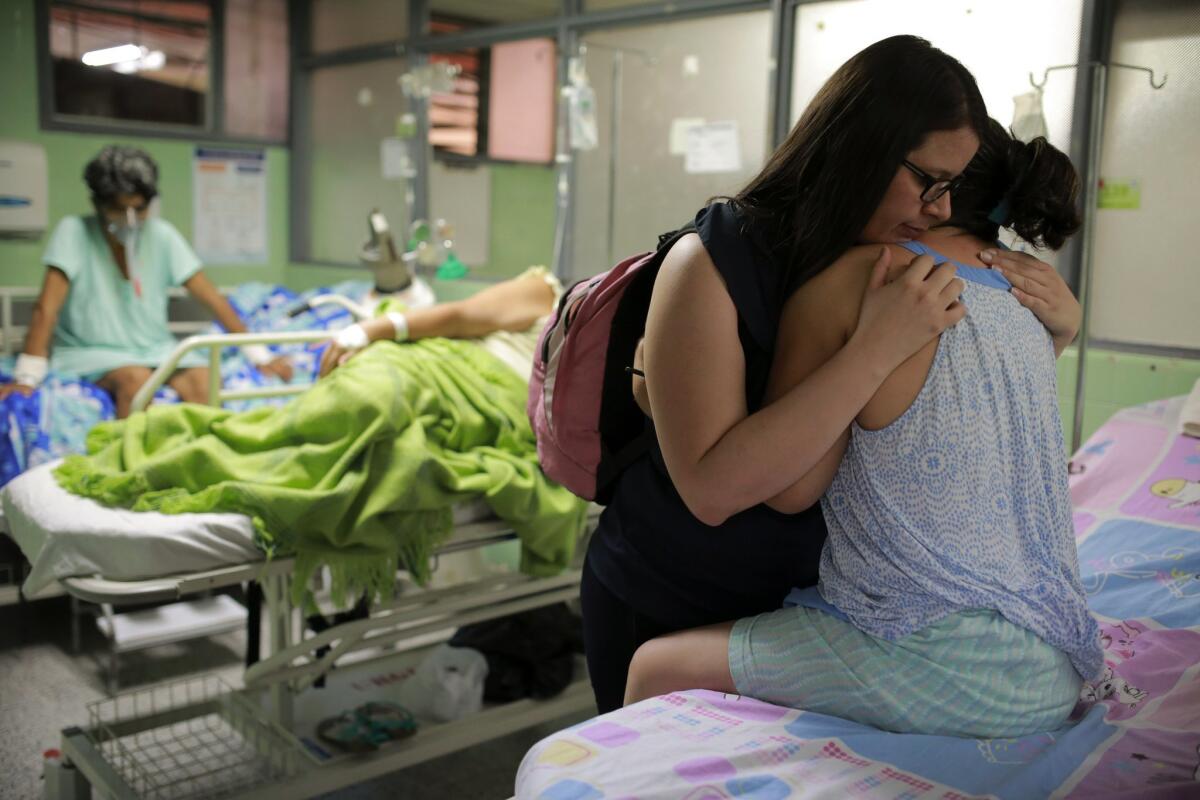Zika virus: First cases of microcephaly reported in Colombia

Xiojanni Badillo in February embraces her aunt Daysi Mendoza, who is recovering from Gullain-Barre syndrome at a hospital in Cucuta, Colombia. Mendoza was diagnosed with the Zika virus days before showing Guillain-Barre symptoms.
Reporting from Colombia — Word that the Zika epidemic has begun to recede in Colombia was overshadowed this week by news that the country, one of the hardest hit by the virus, has reported its first known cases of microcephaly, a birth defect featuring smaller than normal heads in newborns.
The Colombian health ministry confirmed on Friday a dramatic drop in new cases of Zika, a virus that can cause fetal birth defects if pregnant women are infected. The virus, which has infected 64,839 Colombians since September, is also associated with Guillain-Barre syndrome, a type of paralysis.
Suspected new Zika cases reported during the first week in April totaled 2,022 -- one-third as many as at the height of the epidemic in early February. Colombian officials now predict that the epidemic should end by late June. They also lowered their projection of expected cases to 220,000 from the previous 600,000.
But health vice minister Fernando Ruiz Gomez also told reporters Thursday that two cases of microcephaly have been confirmed and that the number will soon rise. Based on the incidence of the birth defect in past Zika outbreaks in other countries, Colombia will see 95 to 300 microcephalic babies born through September, Ruiz said.
“We could be entering a phase of increases in cases of microcephalia,” Ruiz said. He declined to identify the cities where the two affected babies were born, saying only they are in the states of North Santander in northeastern Colombia and Cundinamarca in central Colombia.
Although overshadowed by the scope of the epidemic in Brazil, where hundreds of microcephalic births have been reported, this tropical country has also been hit hard by the virus. The carrier mosquito Aedes aegypti can thrive anywhere below an altitude of 7,000 feet, which is home to 70% of the Colombian population.
The World Health Organization has declared an “emergency health crisis” in Colombia due to the Zika epidemic. This week the U.S. Centers for Disease Control and Prevention confirmed a direct link between Zika and microcephaly.
Ruiz emphasized that microcephalia occurs only in a small subset of pregnant women infected with Zika. Of the total 11,776 pregnant Colombian women diagnosed with Zika since September, 2,756 of them have now given birth to apparently healthy babies.
Total Guillain-Barre syndrome cases so stand at 277, a figure that could rise to 380 by June, said ministry epidemiologist Claudia Cuellar. Although the disease usually causes only short-term symptoms including partial paralysis, some patients are left with lasting muscle damage.
Dr. Marta Ospina, the director of Colombia’s National Institute of Health, cautioned that microcephaly is not the only neurological effect that Zika could have on newborns. Encephalitis and learning disabilities are other possible effects on victims.
Special correspondent Kraul is based in Bogota.
MORE ON THE ZIKA VIRUS
Five ways scientists are going after the Zika virus
Even in peak mosquito season, Zika risk is low in California
10 ways to keep yourself safe from Zika, now definitively linked to birth defects
More to Read
Sign up for Essential California
The most important California stories and recommendations in your inbox every morning.
You may occasionally receive promotional content from the Los Angeles Times.









